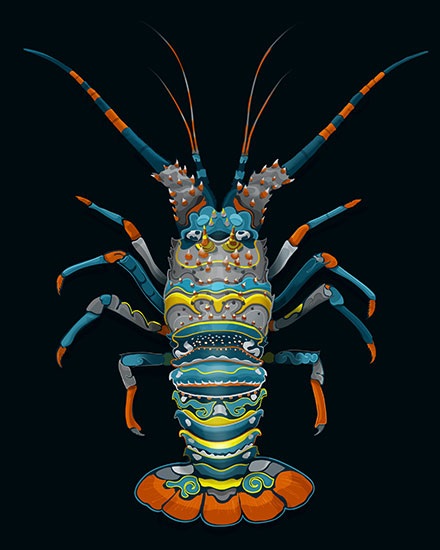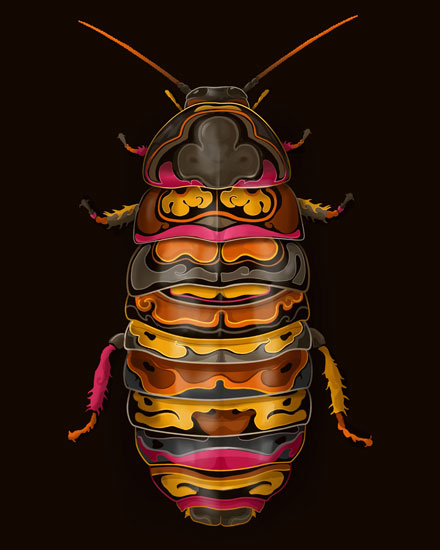Stranger Things
These researchers go beyond traditional mammal models to investigate the weird and unusual in the animal kingdom.
By Marijke Vroomen Durning, RN

When thinking of animal studies, most laypeople think of rats, mice or other mammals as test research subjects. But if we go back to the 17th to 19th centuries, biologists didn’t study mouse models; they looked at a variety of organisms to learn and understand general principles of biology.
“The comparative approach really is a founding approach to understanding how biological systems operate,” explains James W. Hicks, PhD, FAPS, a professor of ecology and evolutionary biology at the University of California, Irvine. His research focuses on vertebrates and spans several groups, from fish to humans. “You can look back, all the way to the 1660s when Robert Boyle was using his pneumatic engine to investigate the effects of lowered air pressure on a whole variety of animals. Boyle placed birds, mice, eels, snails and flies [in an air pump] and noticed that some of the animals, such as the eels, were more tolerant of the reduced air pressure and that the lower air pressure influenced the insects’ ability to fly.”
Looking at animals outside the mammalian model organism allows researchers to reveal what evolutionary possibilities exist in the process of natural selection. It allows them to examine potential physiological mechanisms that one would never imagine if researchers only focused on purpose-bred rodents or other mammalian model organisms, such as pigs.
“There are examples throughout history where the comparative approach suddenly revealed something that people didn’t know or think about, such as the study of fever, which, historically, was thought of as something that wasn’t a good thing,” Hicks explains.
Studying mammals helped researchers learn what fever might mean, but by the early 1970s the role or purpose of fever remained unknown. Physiologist Matthew Kluger, PhD, wondered what happened in reptiles who regulate their body temperatures differently from mammals. “What it revealed was that fever was actually something that was very old evolutionarily and may actually have a benefit,” Hicks says. Kluger’s work changed the view of fever. Relying wholly on mammalian models, this fundamental feature would have been missed.
THE HELPFUL HISSING COCKROACH

Heidy Contreras, PhD, who moved this summer from her associate professor of biology position at the University of LaVerne, in LaVerne, California, to work at California State University, San Bernardino, chose early in her career to study insects. She began with fruit flies, beetles and moths and then settled on hissing cockroaches.
“Insects are invaluable,” she says. “They provide so many services, ecological services, that we don’t even think about. Like cockroaches—they’re scavengers and they go in and clean up our environment without us even thinking about it. … They’re really important in all sorts of ecosystems.”
Hissing cockroaches are fascinating, she says. While working on a project on the specific dynamic action of these insects, she and her students kept getting odd data. They pulled back and went back to the fundamentals, like figuring out how long it took for the cockroaches to process meals. “We discovered that there is still a lot that needs to be discovered about the physiology of cockroaches, including basic metabolic pathways and mechanisms.”
Getting people to understand her fascination with these creatures can be challenging. Still, Contreras says that when she gets potential students in the lab, they hold a cockroach, and although they may still feel some disgust over the insect, their curiosity is sparked. They start asking questions, like how to tell whether it’s male or female. “It really changes their perspective,” she says.
Contreras’ research goals include understanding the physiology, ecology and evolution of animal behavior and motivating and advancing the field of conservation biology. These goals have led to her work within the community. To help declining animal populations recover, we need students interested and engaged in science in school and outside the classroom, she explains, but we also need members of the local communities engaged in the work.
Before the COVID-19 pandemic, Contreras started a program in which she and her students traveled to an Indigenous community in Guatemala to establish a community-based research project. They explored the connection between insect physiology and behavior as it relates to changes in water quality due to climate change. She and her students will apply the same work in a California lake closer to home.
“I am interested in local communities learning more about the effects of climate change on the physiology and behavior of important organisms such as insects and other invertebrates,” Contreras says.
LOBSTER LOVE
According to Patsy Dickinson, PhD, Josiah Little Professor of Natural Sciences and director of the neuroscience program at Bowdoin College in Brunswick, Maine, invertebrates have a lot to teach researchers. Dickinson’s research focuses on lobsters and crabs as she works on understanding the ability of the nervous system to generate flexibility in patterned movements, among other things. She discovered the lobster research randomly, she explains.
“I went to a lab in France to do a postdoc, and they worked on spiny lobsters,” she says. “I realized that crustacean nervous systems had a lot to offer. The nerves are very well-defined, and there are networks that are made of relatively few nerve cells, so you can really see what is happening.”
While she acknowledges that lobsters and mammal systems are very different, crossovers in findings help scientists understand how the networks work.
“Not all the details are going to be the same,” she says, “but the basic principles that govern the function of these tend to be similar across species.”
Frank van Breukelen, PhD, and his colleagues first brought tenrecs to the lab in 2015, and they learned that the animals do things that nobody else can do. “We’re looking at that ancestral condition. This is how mammals used to hibernate. We were biased because we all studied hibernation in modern mammals, and now the tenrecs are changing how we look at hibernation.”
Like Hicks’ opinion about the value of earlier physiology research from other types of animals, Dickinson believes that studying invertebrates allows researchers to learn a lot about the complexities of seemingly simple systems.
“The first thing I worked on was a single neuron,” she explains. “If you stimulate it, it just changed the entire output of the system; the same network was producing a very different output. That had never really been seen before. It was sort of astounding that you could have one neuron that would change the way the pattern was acting.”
Dickinson believes that physiologists entering the field need to learn where the science comes from.
“A lot of the fundamentals of our understanding of physiology came from these other systems, and a lot is still being done in them,” she says. “If you think about physiology broadly, you think about the Krogh principle, which basically says that there are some systems and species that are best for looking at each aspect of physiology and it’s not necessarily all mice and rats.”
She points out that there isn’t one animal equivalent to humans, so the more details researchers get from different species, the more they have to work with.
BIRD BRAINS
Birds are another animal that many may not consider when thinking about animal research. Still, they play an essential role in a lab at the University of Florida in Gainesville. Jessica Whitaker-Fornek, PhD, a postdoctoral fellow at the university, grew up on a farm surrounded by ostriches and other birds. Before settling on her current research, Whitaker-Fornek worked with ducks (in a cypress swamp), beetles and wild mice.
She also worked on a project that studied bird behavior related to loud noise in the environment before studying chicken embryos. “I was studying their movement behavior because chicken embryos are just like a human baby in the womb,” she says. “They kick and move their legs around, and this experience is very important to them because once they hatch, they’re able to walk correctly.”
Whitaker-Fornek then became interested in how the birds’ nervous system developed within the egg so that they could move around and start finding food when they were ready to hatch. She eventually ended up studying baby zebra finches, which start breathing within the eggshell about a day before they hatch. “So that way, when they are completely free of the eggshell, they’re able to breathe normally,” she explains. “The full two weeks leading up to hatching they’re not using their lungs at all to breathe; they’re just using these vascularized membranes surrounding the eggshell.”
Although Whitaker-Fornek is currently studying mice, when she becomes a principal investigator, she intends to return to birds with her own lab. Birds are surprisingly similar to humans in some ways, she explains.
“In general, birds have inhalation and exhalation, and they are endothermic, or warm-blooded,” she says. “They also have an upright posture, which is similar to humans. And when their babies hatch, they are developmentally immature, so they require a large amount of parental care. What we can learn from them, hopefully, will also inform us as to how our own breathing circuits develop when we are in the womb.”
Much early research was done on birds, Whitaker-Fornek points out. “If you’re reading the scientific literature, in many papers from the early- to mid-1900s, a lot of the work is performed in birds or bird embryos. Now there’s been a move away from working with birds. For example, Jason Pilarski’s lab at Idaho State University where I worked was definitely the only lab that was studying the development of breeding circuits in birds.”
TENRECS—THE ‘DINOSAUR’ OF MAMMALS?
Frank van Breukelen, PhD, a professor in the School of Life Sciences at the University of Las Vegas, studies animals that survive in harsh environments such as hibernators. He was inspired by his undergraduate research mentor, Steven Wickler, PhD, DVM. Wickler asked how animals that hibernate can maintain muscle strength when they emerge from hibernation after six months of inactivity. Van Breukelen asks: “How do animals even hibernate?” “It didn’t make any sense to me,” he said.
Van Breukelen’s work focuses on tenrecs, which are mammals endemic to Madagascar. Tenrecs are nocturnal animals that look similar to hedgehogs, but the two aren’t related. Van Breukelen was drawn to the animals because of Barry Lovegrove, PhD, who was a senior professor and specialist in evolutionary physiology in the School of Biological and Conservation Sciences on the local campus of the University of KwaZulu-Natal in Durban, South Africa.
“Barry died earlier this year, but he gave a talk at a meeting where he was talking about how [tenrecs] don’t do interbout arousals. In my mind, I had established all these models for hibernation that involved the interbout arousal. And suddenly there was this animal that doesn’t do it.”
Usually, when animals hibernate, they don’t just go into a state of hibernation and stay torpid the entire time. “What they do—in the case of ground squirrels, for example—is they go down for one to three weeks, then they come up for 24 hours or so and then they repeat the cycle over and over again, up to 15 times per year. These interbout arousals allow for resetting of homeostasis. But tenrecs don’t do that,” van Breukelen says.
He and his colleagues first brought tenrecs to the lab in 2015, and they learned that the animals do things that nobody else can do. “We’re looking at that ancestral condition. This is how mammals used to hibernate. We were biased because we all studied hibernation in modern mammals, and now the tenrecs are changing how we look at hibernation.”
While most people think of hibernation as something associated with winter and cold weather, the work with the tenrecs shows something different. “I would argue that hibernation did not evolve for overwintering or for cold temperatures. That’s a later addition.” Instead, the researchers believe that hibernation was more for predator avoidance. Van Breukelen points out that it’s quite hot in much of Madagascar, furthering this belief.
Tenrecs “are really sort of a throwback to something different,” van Breukelen says. In another example, tenrecs have a cloaca, one common cavity at the end of the digestive tract and genital opening. This is present in birds, reptiles and other animals, but not other mammals.
If van Breukelen has any regrets when it comes to his research, he says it’s that he didn’t start studying these fascinating animals earlier.
THE PLACES YOU WILL GO
Research with “nontraditional” animals can lead scientists down paths they never expected. Hicks, for example, was a consultant for the popular 2008 Pixar movie “WALL-E.” One of his colleagues had worked with the company on the movie “Finding Nemo,” and when Pixar came calling for “WALL-E,” the colleague referred Hicks because he had been working with a grant from NASA on the effects of weightlessness.
“I gave a lecture to the entire crew and everybody involved in the film about what happens in space and microgravity,” he says. “I think that’s where it spurred the idea of having the humans on floating chairs that took them everywhere.”
Microgravity affects the human body on Earth and is researched with bedrest studies, for example. “The studio wanted to know as much science as possible.”
Given the definition of comparative physiology—learning about evolutionary relationships between different organisms and animals—working with animals outside of rodents and other small mammals allows researchers to dig deeper into the evolution of biological functions. This may lead to a better understanding of human behavior and the world around us.
This article was originally published in the September 2022 issue of The Physiologist Magazine.
“There are examples throughout history where the comparative approach suddenly revealed something that people didn’t know or think about, such as the study of fever, which, historically, was thought of as something that wasn’t a good thing.” James W. Hicks, PhD, FAPS
The Physiologist Magazine
Read the Latest Issue
Don’t miss out on the latest topics in science and research.
Contact Us
For questions, comments or to share your story ideas, email us or call 301.634.7314.


